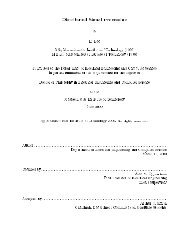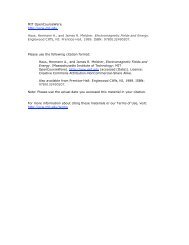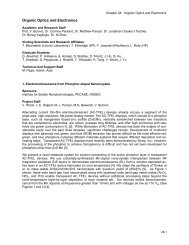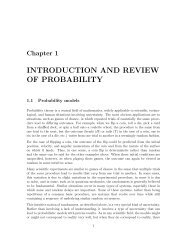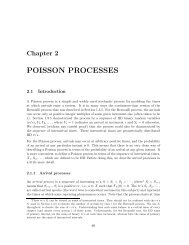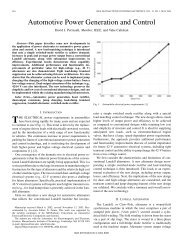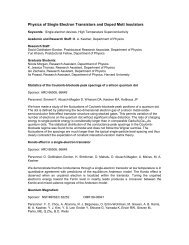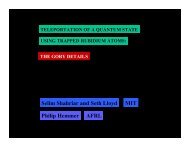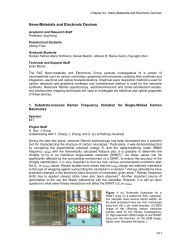RLE Progress Report No - Research Laboratory of Electronics - MIT
RLE Progress Report No - Research Laboratory of Electronics - MIT
RLE Progress Report No - Research Laboratory of Electronics - MIT
Create successful ePaper yourself
Turn your PDF publications into a flip-book with our unique Google optimized e-Paper software.
1<br />
0.1<br />
ne<br />
Te<br />
Ti<br />
0.01<br />
100 200 300 400<br />
Location from target (z) in µ m<br />
Figure 1: Laser produced plasma in TRIDENT; n e in units <strong>of</strong> n e /n cr ,<br />
T e and T i in keV (from Ref.1).<br />
The basic experimental setup is illustrated in Figure 13 <strong>of</strong> our last report 2 , where a laser beam is<br />
focused into a plasma that is created from a plastic foil. 1 The plasma is approximately<br />
homogeneous along the beam path, but changes its density and temperature as it flows away<br />
from the target. By focusing the laser at different positions from the target, experimentalists have<br />
studied the SRS backscattering for the different parameters shown in Figure 1.<br />
Considering a weak nonlinear interaction <strong>of</strong> the five waves, we express this as nonlinearly<br />
coupled field amplitudes that change slowly in time and space. The equations that describe the<br />
interaction between the slowly varying amplitudes ( a 1<br />
, a ,<br />
2<br />
a ,<br />
3<br />
a and<br />
4<br />
a , for the Laser, BEMW,<br />
5<br />
EPW, BEPW and IAW, respectively) are:<br />
( ∂ + v ∂ + γ ) a = −K<br />
a SRS<br />
a , (1)<br />
t g1<br />
x 1 1<br />
t<br />
+ vg2∂<br />
x<br />
+ 2<br />
)<br />
2 =<br />
2<br />
1<br />
3<br />
3<br />
( ∂ γ a K a SRS<br />
a , (2)<br />
( ∂ + v ∂ + γ ) a = K a a − K a a , (3)<br />
t<br />
g3<br />
x 3 3 SRS 1 2<br />
t<br />
+ vg4∂<br />
x<br />
+ 4)<br />
a4<br />
=<br />
LDI<br />
t<br />
+ vg5∂<br />
x<br />
+ 5)<br />
a5<br />
=<br />
LDI<br />
3<br />
LDI<br />
( ∂ γ K a a , (4)<br />
3<br />
5<br />
( ∂ γ K a a . (5)<br />
4<br />
4<br />
5<br />
2<br />
In Eqs. (1)–(5), a<br />
<br />
= W<br />
/ ω ,<br />
<br />
W ,<br />
<br />
v and<br />
g<br />
γ are the wave action density, wave energy density,<br />
<br />
group velocity and damping rate <strong>of</strong> mode . The nonlinear coupling coefficients are:<br />
K<br />
SRS<br />
≈<br />
2<br />
ε<br />
o<br />
1/ 2<br />
2<br />
e k ⎛ ω ⎞<br />
3 pe ,<br />
m<br />
e<br />
⎜ ⎟<br />
4<br />
⎝ω1ω<br />
2ω<br />
3 ⎠<br />
K<br />
LDI<br />
≈<br />
2<br />
ε<br />
o<br />
m e<br />
1/ 2<br />
e ω pe ⎛ ω ⎞<br />
5<br />
4v<br />
⎜<br />
⎟<br />
.<br />
Te ⎝ω3ω<br />
4 ⎠<br />
Such model equations have also been considered in the past 3 but their solution was not explored<br />
in much detail nor related to experiments in relatively homogeneous plasmas.<br />
2 R. J. Focia, A. Bers, and A. K. Ram., “Plasma Electrodynamics and Applications: Section 5 – Electromagnetic Decay<br />
Instability in Single Hot Spot Geometry”, <strong>Progress</strong> <strong>Report</strong> <strong>No</strong>. 142, <strong>MIT</strong> <strong>Research</strong> <strong>Laboratory</strong> <strong>of</strong> <strong>Electronics</strong>, Cambridge,<br />
2000 (http://rleweb.mit.edu/Publications/pr142/bers142.pdf).<br />
3 J. A. Heikkinen and S. J. Karttunen, “Intensity Saturation <strong>of</strong> Stimulated Raman Scattering by Ion-Wave Coupling,” Phys.<br />
Fluids, 29(4), 1291 (1986).



